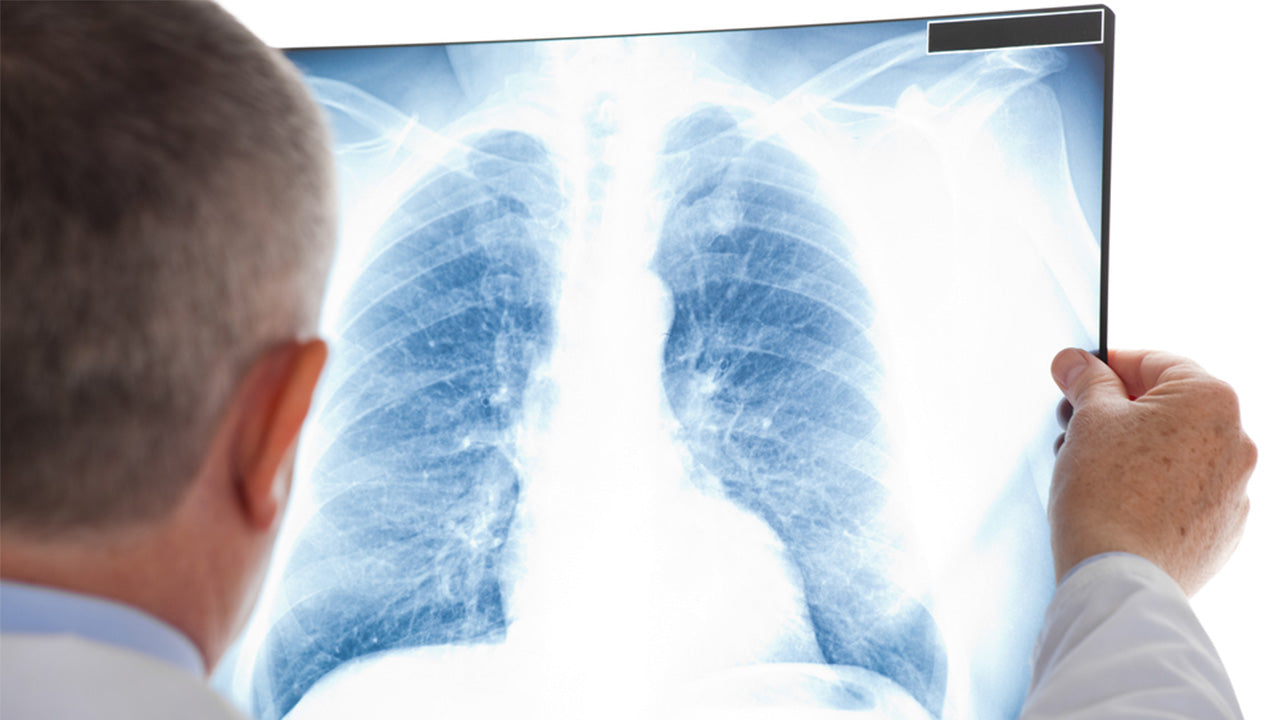Pulmonary Fibrosis: Prognosis and Life Expectancy
 By: by Amino Science
By: by Amino Science

Pulmonary fibrosis belongs to a family of conditions known as interstitial lung disease. Interstitial lung diseases affect the lung interstitium—the supportive tissue surrounding the air sacs. While some interstitial lung diseases cause inflammation, most lead to progressive scarring. This scarring of the lungs is referred to as pulmonary fibrosis. According to the Pulmonary Fibrosis Foundation, approximately 200,000 people in the United States are currently living with pulmonary fibrosis.
In this article, we’re going to take a look at this chronic lung disease and discuss everything you need to know about prognosis, life expectancy, and available treatments.
What Is Pulmonary Fibrosis?
Pulmonary fibrosis refers to a group of over 200 different lung diseases, all of which are similar in nature. When the lung interstitium develops scarring, or fibrosis, the normal lung tissue is replaced by fibrous connective tissue. Because this fibrous tissue is thicker and stiffer than normal lung tissue, it can be more difficult to get enough oxygen into the blood. The combination of lower oxygen levels and stiff lung tissue can lead to progressive shortness of breath, especially when engaging in activity.
Pulmonary Fibrosis Causes
Pulmonary fibrosis can be caused by a variety of different factors. However, in most situations, the cause is never found, so most cases of pulmonary fibrosis are classified as idiopathic pulmonary fibrosis (IPF). Other types of pulmonary fibrosis may be caused by:
- Work history: Occupations that involve exposure to lung irritants like asbestos fibers or coal, silica, or grain dust can lead to pulmonary fibrosis.
- Environment: Contaminants in the environment such as mold, chemicals, and animal feces can cause pulmonary fibrosis.
- Medical conditions: Health problems like mixed connective tissue disease, systemic lupus erythematosus, sarcoidosis, rheumatoid arthritis, and pneumonia can lead to pulmonary fibrosis.
- Radiation: People who’ve been exposed to radiation as part of treatment for breast or lung cancer can develop pulmonary fibrosis months or years after therapy.
- Medications: Certain antibiotics as well as chemotherapy, heart, and anti-inflammatory drugs can lead to pulmonary fibrosis.
Risk Factors for Pulmonary Fibrosis
Certain risk factors can make an individual more susceptible to developing pulmonary fibrosis. These include:
- Family history: Some types of pulmonary fibrosis, including a rare form called familial pulmonary fibrosis, are known to run in families.
- Age: Although pulmonary fibrosis can occur at any age, it’s most likely to affect adults ages 50 to 70.
- Sex: Men are more likely than women to develop IPF.
- Smoking: Both current and former smokers have a greater risk of developing pulmonary fibrosis.
Pulmonary Fibrosis Symptoms
The most common symptoms seen with pulmonary fibrosis are shortness of breath and a dry, hacking cough. Additional symptoms of pulmonary fibrosis include:
- Unexplained weight loss
- Muscle and joint pain
- Fatigue
- Weakness
- Chest discomfort
While symptoms may be absent during the early stages of pulmonary fibrosis, the progressive nature of the disease can eventually result in shortness of breath with even everyday activities. In addition, low levels of oxygen in the blood can cause the fingers and toes to develop a condition known as clubbing, or softening and swelling of the nail beds, with subsequent downward curving of the nails.
Pulmonary Fibrosis Complications
As pulmonary fibrosis progresses, it may lead to a number of complications, including:
- Pulmonary hypertension (elevated blood pressure in the lung arteries)
- Right-sided heart failure
- Lung cancer
- Pulmonary embolism
- Lung infections
- Respiratory failure
Diagnosing Pulmonary Fibrosis
Because the symptoms of pulmonary fibrosis can resemble those of so many other medical conditions, the disease can be difficult to diagnose. Therefore, any symptoms associated with pulmonary fibrosis should be shared with your health care provider right away.
After discussing your symptoms as well as family history and possible exposure to lung toxins, your health care provider will perform a physical exam to evaluate lung function. In addition, a series of tests may be performed. These include:
- Chest X-ray: A chest X-ray can be used to identify signs of scar tissue in the lungs.
- Computed tomography (CT) scan: A CT scan—particularly a high-resolution CT scan—is more sensitive than a regular chest X-ray and can be helpful in evaluating the degree of lung damage.
- Pulmonary function test: This noninvasive test can be used to measure how well the lungs are functioning at rest.
- Exercise stress test: An exercise stress test can be performed to measure how well the lungs are functioning during exercise.
- Biopsy: Sometimes it’s necessary to obtain a sample of lung tissue to evaluate for signs of pulmonary fibrosis. A lung biopsy can be obtained using a minimally invasive procedure like bronchoscopy or even surgery.
Pulmonary Fibrosis Treatment
Pulmonary fibrosis is a highly individualized disease that may progress rapidly in one person and slowly in another—or it may remain stable for long stretches, punctuated by periods of acute exacerbation. Therefore, therapy tends to be highly personalized, though treatment options may include:
- Medications: Two of the newer medications used to treat pulmonary fibrosis are nintedanib (Ofev), an anti-fibrotic drug, and pirfenidone (Esbriet), an anti-fibrotic and anti-inflammatory medication, both of which are used in the treatment of IPF. Other types of pulmonary fibrosis may be treated with medications like steroids, mycophenolate mofetil (CellCept), and azathioprine (Imuran) to address inflammation.
- Oxygen therapy: If pulmonary fibrosis has progressed to the point where oxygen levels in the body have begun to decrease, supplemental oxygen may be prescribed to make breathing easier.
- Pulmonary rehabilitation: This type of intervention involves a combination of approaches designed to increase awareness of the disease and improve overall functioning and well-being and generally consists of education, exercises, breathing techniques, nutritional counseling, and emotional support.
- Lung transplantation: People with advanced pulmonary fibrosis may want to consider a lung transplant. While a transplant can improve quality of life and increase life expectancy, transplant surgery is a major procedure and may lead to complications, such as rejection and infections.
Prognosis and Life Expectancy
As mentioned, the rate of progression of pulmonary fibrosis can vary widely depending on the individual. Moreover, treatment is continually advancing, and early diagnosis, active involvement in care, lifestyle choices, and overall health can have a huge impact on prognosis.
Some of the best ways to improve prognosis include:
- Not smoking: As discussed earlier, smoking increases the risk of developing pulmonary fibrosis, and continuing to smoke after diagnosis only worsens prognosis. So if you smoke, speak with your health care provider about techniques that may help you quit.
- Eating a healthy diet: The shortness of breath that accompanies pulmonary fibrosis can make eating difficult, but good nutrition is essential for combating the disease. Therefore, aim for smaller, more frequent meals throughout the day and incorporate a variety of fresh fruits and vegetables, whole grains, lean protein, and healthy fats.
- Getting regular exercise: Pulmonary fibrosis can make exercise difficult, but regular activity helps maintain and even improve lung function. Both oxygen therapy and pulmonary rehabilitation can help improve exercise tolerance, as can a specially formulated blend of essential amino acids (click here to learn more).
- Learning to relax: Techniques such as meditation, biofeedback, and tai chi can help reduce the feelings of anxiety that often occur in people with pulmonary fibrosis.
- Getting plenty of sleep: Sufficient sleep is absolutely necessary to support the immune system and promote overall well-being.
- Finding a support group: Being able to talk with other people who are going through what you’re going through can reduce feelings of hopelessness and encourage a sense of empowerment.
Being diagnosed with pulmonary fibrosis can be both frightening and stressful. But by staying actively involved in your therapy, taking care of your overall health, and working with your health care provider to find the treatment plan that’s right for you, you can improve your well-being and add years to your life.


Up to 25% off Amino
Shop NowTAGS: conditions
Join the Community
Comments (0)
Most Craveable Recipes




 833-264-6620
833-264-6620



















